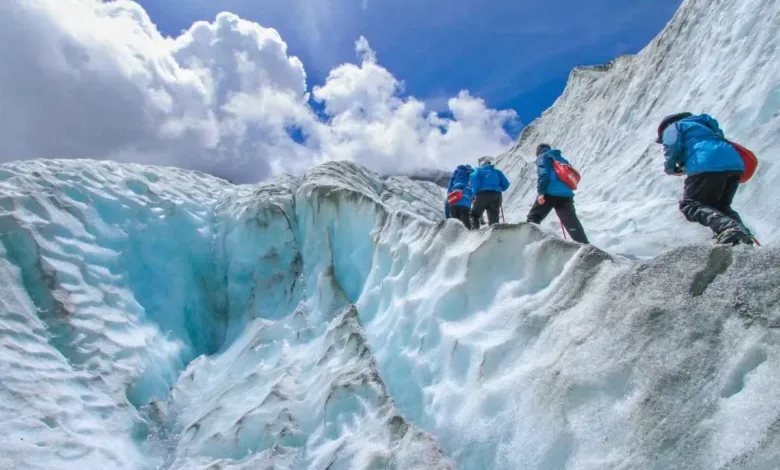
What is Mountain Climbing?
Mountain climbing is a challenging and rewarding activity that offers numerous benefits for both physical and mental health. In this blog, we will explore the different types of mountaineering, the differences between mountain climbing and hiking, as well as the benefits that come with engaging in this exciting sport. Whether you are a seasoned climber or a beginner looking to try something new, this guide will provide valuable information on what mountain climbing is all about.
Mountain climbing
Mountain climbing, also known as mountaineering, is the sport, hobby, or profession of climbing mountains. It involves ascending a mountain or a peak, usually on foot or with the help of specialized equipment, such as ropes, harnesses, crampons, ice axes, and other safety gear.
Mountain climbing can vary in difficulty from relatively easy hikes up small hills to challenging and technically demanding climbs on the highest and most difficult mountains in the world. Some people engage in mountain climbing as a way to enjoy nature and challenge themselves physically and mentally, while others pursue it as a competitive sport or as a means of exploring remote and rugged landscapes.
Difference between Mountain Climbing and Hiking?
Mountain climbing and hiking are both outdoor activities that involve walking in natural settings, but there are some key differences between the two.
Hiking is generally considered to be a more leisurely activity that involves walking on established trails or paths through natural areas like forests, mountains, and parks. Hiking can range from easy to strenuous, depending on the terrain and distance covered, and typically does not require specialized equipment or technical skills beyond basic navigation and fitness.
Mountain climbing, on the other hand, involves ascending steep or vertical terrain, often with the use of specialized equipment such as ropes, harnesses, and climbing shoes. Mountain climbers usually aim to reach the summit of a mountain or a specific peak, which requires advanced technical skills, physical fitness, and sometimes acclimatization to high altitudes. Mountain climbing can be dangerous and should only be attempted by experienced climbers with proper training and equipment.
Hiking is a more accessible and leisurely activity that involves walking on established trails, while mountain climbing is a more specialized and challenging activity that involves ascending steep terrain using specialized equipment and technical skills.
Types of mountaineering
Mountaineering can generally be divided into several different types, based on the objectives and techniques used. Here are some common types of mountaineering.
- Rock climbing.
- Ice climbing.
- Alpine climbing.
- Expedition climbing.
- Ski mountaineering.
- Big wall climbing.
- Mixed climbing.
- Bouldering
-
Rock climbing
This type of mountaineering involves climbing up rock faces using specialized equipment such as ropes, harnesses, and climbing shoes.
-
Ice climbing
Ice climbing involves climbing frozen waterfalls, ice-covered rock faces, and glaciers using specialized equipment like crampons, ice axes, and ropes.
-
Alpine climbing
This type of mountaineering involves ascending peaks in high-altitude environments using a combination of rock, snow, and ice climbing techniques.
-
Expedition climbing
Expedition climbing is a type of mountaineering that involves multi-day or multi-week trips to remote and often extreme environments, such as the Himalayas or the Antarctic.
-
Ski mountaineering
Ski mountaineering is a type of mountaineering that involves ascending peaks on skis and then skiing back down.
-
Big wall climbing
This type of mountaineering involves climbing large, multi-pitch rock faces, often involving overnight bivouacs on the wall.
-
Mixed climbing
Mixed climbing involves a combination of rock, ice, and snow climbing techniques, often on steep and technical terrain.
-
Bouldering
Bouldering involves climbing short, difficult routes on large boulders or small cliffs. This type of mountaineering does not require ropes but requires specialized equipment, including climbing shoes, chalk, and crash pads.
The Benefits of Mountain Climbers
Mountain climbing is a challenging and physically demanding activity that offers numerous benefits for both physical and mental health. Here are some of the key benefits of mountain climbers.
- Builds strength and endurance.
- Promotes weight loss.
- Promotes weight loss.
- Reduces stress.
- Boosts mental toughness.
- Improves balance and coordination.
- Provides a sense of accomplishment.
- Connects individuals with nature.
Builds strength and endurance
Mountain climbers require a lot of physical strength and endurance, especially in the legs, core, and upper body. Regular mountain climbing can help build muscle strength, improve cardiovascular health, and increase overall endurance.
Promotes weight loss
Mountain climbing is a high-intensity, calorie-burning activity that can help with weight loss and weight management. Climbing steep inclines and rocky terrain requires a lot of energy and burns a significant number of calories.
Reduces stress
Mountain climbing can be a great stress-reliever as it allows individuals to disconnect from the hustle and bustle of daily life and focus on the task at hand. Being in nature and engaging in physical activity also releases endorphins, which can help reduce stress and improve mood.
Boosts mental toughness
Mountain climbing requires a lot of mental toughness, perseverance, and problem-solving skills. Overcoming challenges and achieving goals can help build confidence, self-esteem, and resilience.
Improves balance and coordination
Mountain climbing involves navigating uneven terrain, steep inclines, and obstacles, which can help improve balance, coordination, and spatial awareness.
Provides a sense of accomplishment
Mountain climbing is a challenging activity that requires a lot of dedication, hard work, and training. Successfully summiting a peak can provide a sense of accomplishment and a feeling of personal achievement.
Connects individuals with nature
Mountain climbing provides an opportunity to connect with nature, explore new environments, and appreciate the beauty of the natural world. This can be a transformative and inspiring experience for many climbers.
You may like:




